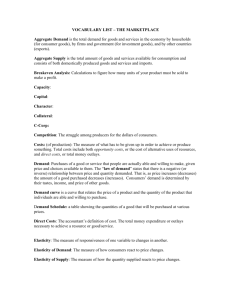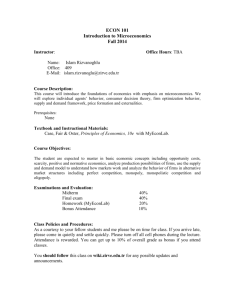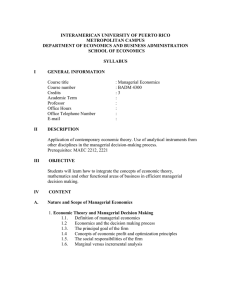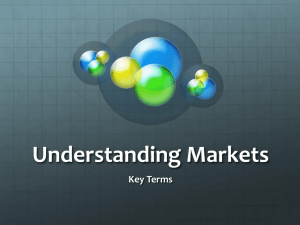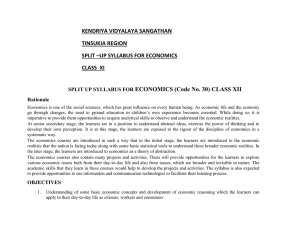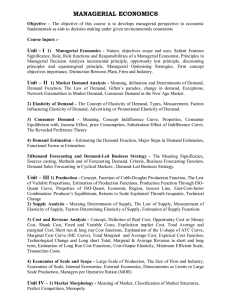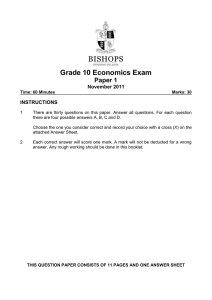eefa-quiz
advertisement
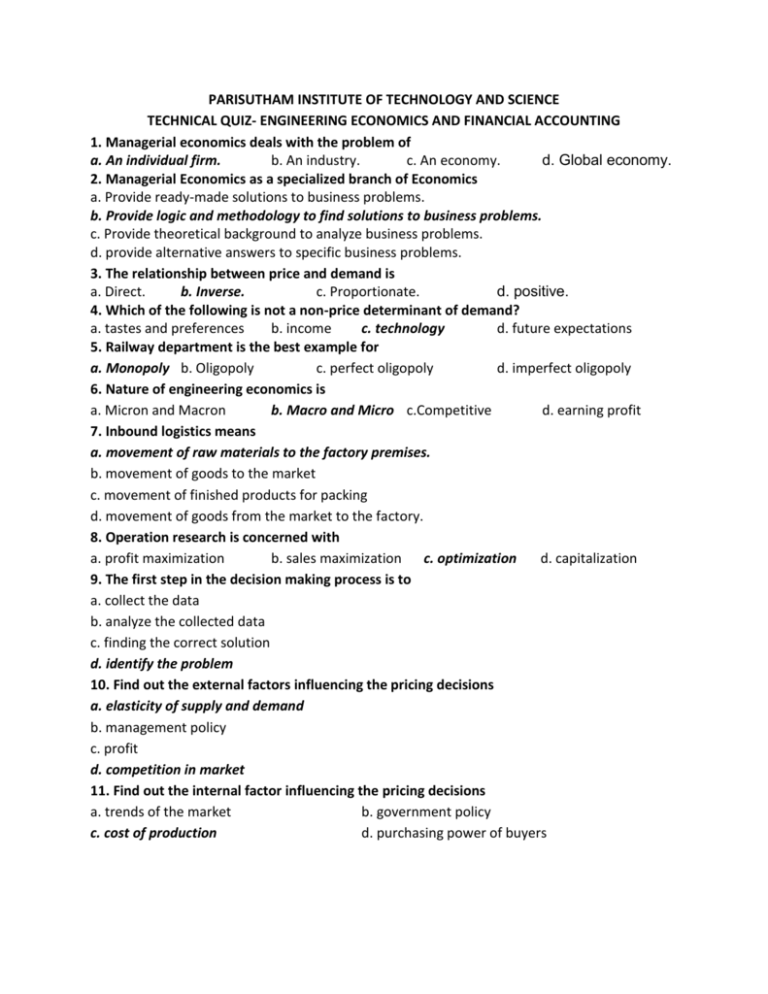
PARISUTHAM INSTITUTE OF TECHNOLOGY AND SCIENCE TECHNICAL QUIZ- ENGINEERING ECONOMICS AND FINANCIAL ACCOUNTING 1. Managerial economics deals with the problem of a. An individual firm. b. An industry. c. An economy. d. Global economy. 2. Managerial Economics as a specialized branch of Economics a. Provide ready-made solutions to business problems. b. Provide logic and methodology to find solutions to business problems. c. Provide theoretical background to analyze business problems. d. provide alternative answers to specific business problems. 3. The relationship between price and demand is a. Direct. b. Inverse. c. Proportionate. d. positive. 4. Which of the following is not a non-price determinant of demand? a. tastes and preferences b. income c. technology d. future expectations 5. Railway department is the best example for a. Monopoly b. Oligopoly c. perfect oligopoly d. imperfect oligopoly 6. Nature of engineering economics is a. Micron and Macron b. Macro and Micro c.Competitive d. earning profit 7. Inbound logistics means a. movement of raw materials to the factory premises. b. movement of goods to the market c. movement of finished products for packing d. movement of goods from the market to the factory. 8. Operation research is concerned with a. profit maximization b. sales maximization c. optimization d. capitalization 9. The first step in the decision making process is to a. collect the data b. analyze the collected data c. finding the correct solution d. identify the problem 10. Find out the external factors influencing the pricing decisions a. elasticity of supply and demand b. management policy c. profit d. competition in market 11. Find out the internal factor influencing the pricing decisions a. trends of the market b. government policy c. cost of production d. purchasing power of buyers 12. Objectives of pricing policy are a. Profit maximization and facing competition b. promotional activities and quality c. increase production d. to satisfy customers 13. Who is called as middle men? a. supplier b. employees c. wholesaler and retailer d. customers 14. FMCG stands for a. Fast moving cosmetics goods b. Frequently moving costly goods c. Fast moving consumer goods d. Fast moving capital goods 15. While penetrating in the new market the manufacturer will fix a. High price b. Dual price c. Low price d. imitative price 16. The type economic problem is a. individual b. universal c. vary from countries d. profit oriented 17. Expansion of supply is shown by the movement in the supply curve which is a. shift towards centre b. shift towards left c. shift towards right d. linear 18. Expansion of demand is shown by the movement in the demand curve which is a. shifted towards left b. constant c. shifted towards right d. linearly increasing 19. Managerial economics aims at providing help in the firms is a. earning profit b. planning c. decision making d. setting goals 20. An industry is a group of firms dealing in the same line of a. work b. market c. products d. business 21 . The act of making goods and services is called a. economics b. production c. operation research d. accounting 22. The act of using goods and services to satisfy wants is called a. consumption b. declaration c. competition d. conclusion 23. Under monopoly entry of new firms is a. free b. prohibited c. tough to enter d. restricted to some extent 24. A firm is a unit of production, where production is done with the aim to maximize a. human power b. profit c. employee skills d. increase production 25. Change in income of a person may result in demand for goods to a. constant b. change c. both a and b d. none of the above 26. In perfect competition the price is fixed where the demand and supply meets the a. maximum position b. equilibrium c. minimum position d. all the above 27. Price of a product under perfect competition is determined by the interaction of total supply and a. Total demand b. total cost c. Total production d. Total employees 28 . Demand forecasts are necessary for a. Fulfillment of objective of the plans b. Preparation of a budget c. Expansion of firms d. All the above 29. Assumptions underlying the law of Supply are a. The cost of production is unchanged b. government policy changes c. employees are constant d. output is constant. 30. Equilibrium is a. The stage of balance b. The stage of imbalance c. upward movement d. none of the above 31. The production function studies a. Input and output relation b. employee ratio c. supplier rate d. all the above 32. Demand Curve explains a. relation between price and demand b. total cost c. firm market status d. none of the above 33. Demand is determined by a. Price of the product b. Relative prices of other goods c. Tastes and habits d. all the above. 34. A change in demand is said to take place when there is a A) Shift of the demand curve. B) Shift of the supply curve. C) Movement along the demand curve. D) Quantity change. 35. A good has a substitute if there exists another good A) whose demand varies inversely with changes in this good's price. B) that is virtually the same. C) that has the same price. D) whose demand varies directly with changes in this good's price. 36. Scarcity is a condition that exists when a. there is a fixed supply of resources. b. there is a large demand for a product. c. resources are not able to meet the entire demand for a product. d. all of the above. 37. A market is in equilibrium when a. supply is equal to demand. b. the price is adjusting upward. c. the quantity supplied is equal to the quantity demanded. d. tastes and preference remain constant. 38. Two goods are _____________ if the quantity consumed of one increases when the price of the other decreases. a. normal b. superior c. complementary d. substitute 39. The degree of responsiveness of supply to a given change in price- is called as a. elasticity of demand b. elasticity of supply c. elasticity of cost d. elasticity of price 40. The quantity of a product demanded by an individual purchaser at a given price is a. market demand B.Individual demand c. product demand d. none of the above STAFF SIGN HOD SIGN


